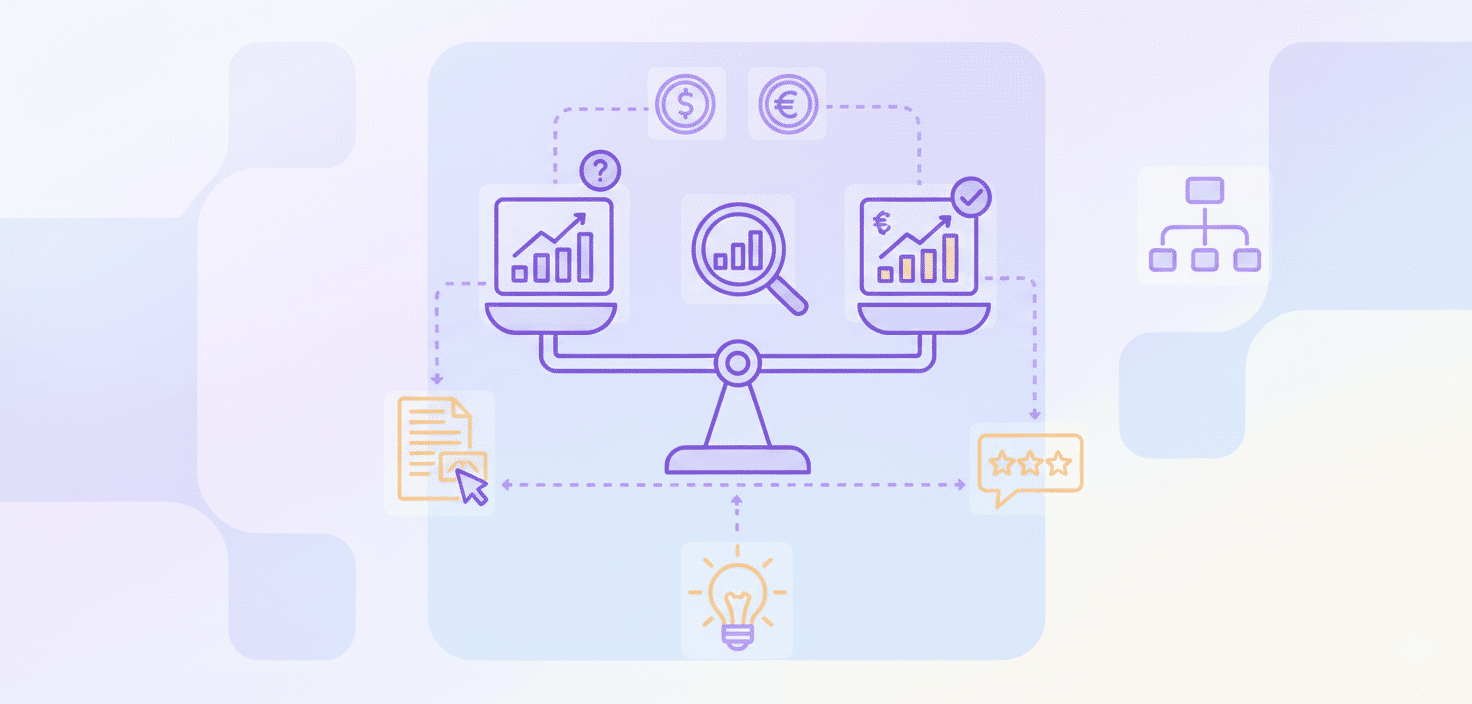가격 전략
SaaS 가격 테스트란 무엇인가요?

SaaS 가격 테스트란 무엇인가요?
SaaS 가격 테스트는 SaaS 제품 또는 서비스의 다양한 가격 지점을 실험하여 수익, 이윤 또는 기타 주요 비즈니스 목표를 극대화하는 이상적인 가격을 찾아내는 과정입니다.
소비자 행동을 평가하고 가격 전략을 개선하기 위해, 양적 기법(A/B 테스트 등)과 질적 기법(고객 인터뷰 등)을 결합합니다.
효과적인 가격 책정 테스트는 다음 사항에 큰 영향을 미칠 수 있습니다:
- 인식되는 제품 가치
- 수익 및 수익성 성장
예를 들어, 한 SaaS 기업은 가장 비싼 티어로 상향 판매(업셀링)를 통해 수익을 30% 증가시키면서 이탈률을 낮출 수 있었습니다.
SaaS 기업의 43%가 연 1회 이상 가격을 검토하는 만큼, 시장과 고객 선호도의 변화에 맞춰 조정하기 위해 가격을 조기에 자주 테스트하는 것이 중요합니다.
시장 분석은 가격 테스트에 어떻게 영향을 미치나요?
시장 분석을 통해 다음과 같은 필수적인 통찰력을 얻을 수 있습니다:
- 경쟁사 가격 구조
- 산업 동향
- 고객 선호도 및 지불 의향
- 이 정보를 통해 SaaS 기업은 다음을 할 수 있습니다:
- 가격을 전략적으로 조정
- 효과적인 마케팅 및 차별화 전략을 개발
- 시장 점유율을 잃지 않으면서 수익성 있는 가격 책정 기회 식별
권장 방법:
- 경쟁 가격 분석
- 선택 기반 컨조인트 (CBC) 분석
모범 사례: 시장 상황 및 고객 기대치가 변화함에 따라 여러 차례 가격 책정 실험을 수행하고 데이터를 사용하여 전략을 개선하십시오.
SaaS 산업에서 테스트하기에 가장 적합한 가격 책정 모델은 무엇인가요?
제품 유형 및 고객 행동에 따라 여러 가격 책정 모델이 테스트에 적합합니다.
일반적인 SaaS 가격 책정 모델
|
모델 |
설명 |
가장 적합한 경우… |
|
단계별 가격 책정 |
기능이 증가하는 여러 가격대 |
고객은 필요와 예산이 다양합니다. |
|
사용량 기반 가격 |
고객은 사용한 만큼 지불합니다. |
제품 참여도에 따라 가치가 증가합니다. |
|
프리미엄 모델 |
무료 진입 단계와 유료 업그레이드 |
목표는 사용자 확보 및 상향 판매입니다. |
|
단수 가격 책정 |
심리적 가격 책정 (예: 49달러 vs 50달러) |
고객은 가격에 민감합니다. |
다양한 모델과 가격대에 대한 A/B 테스트는 매우 중요합니다.
브랜딩은 가격 테스트에 어떻게 영향을 미치나요?
브랜딩은 고객의 가치 인식에 직접적인 영향을 미치며, 따라서 가격 민감도에도 영향을 줍니다.
브랜딩이 가격 책정에 미치는 영향
- 강력한 브랜드는 감성적인 연결을 형성하여 더 높은 가격 허용도를 가능하게 합니다.
- 프리미엄 브랜드는 때때로 경쟁력이 약한 경쟁사보다 최대 두 배의 가격을 책정할 수 있습니다.
강력한 브랜드의 가격 테스트를 수행할 때:
- 모든 채널에서 브랜드 일관성을 유지하세요.
- 가치, 품질 및 고유성을 강조하세요.
- 브랜드 인식을 해칠 수 있는 급격한 가격 변동은 피하세요.
- 브랜드 자산은 가격 결정력을 강화하고 프리미엄 포지셔닝을 지원하는 데 중요한 역할을 합니다.
어떤 가격 요소들을 테스트해야 하나요?
가격 테스트를 수행할 때, 여러 가지 가격 측정 기준을 평가하십시오:
테스트할 요소
- 가격 책정 모델: 원가 가산 방식, 가치 기반, 계층형
- 가격 지점: 달러 가치 변동
- 고객 세그먼트: 인구 통계, 기업 통계
- 지리적 위치: 지역별 가격 민감도
- 고객 행동: 지불 의향, 할인에 대한 반응
이러한 요소를 테스트하면 가격 책정 전략을 최적화하여 다음과 같은 결과를 얻을 수 있습니다:
- 수익 증가
- 고객 만족도 향상
모범 사례: 새로운 기능이나 제품 업데이트가 가치 제안을 변경할 경우, 가격을 정기적으로 재평가해야 합니다. 실험 기간, 트래픽 양, 표본 크기 등 명확한 실험 매개변수를 정의하십시오.
SaaS 가격 책정을 안전하게 테스트하는 단계는 무엇인가요?
SaaS 가격 테스트를 안전하게 실행하려면 구조화되고 데이터 기반의 접근 방식을 따르십시오:
가격을 안전하게 테스트하는 단계
- 연구 및 가설 개발 – 어떤 가격 요인이 고객 행동에 영향을 미칠 수 있는지 파악합니다.
- A/B 테스트 구현 – 고객 세그먼트별로 가격 변형을 테스트합니다.
- 기능 플래그 & 롤아웃 – 점진적 롤아웃을 사용하여 노출을 제어하세요.
- 버전 관리 계획 – 실패한 테스트에 대비하여 롤백 옵션을 유지하세요.
- 핵심 지표 모니터링 – 전환율을 추적하고, 이탈, 실시간으로 참여도를 확인하세요.
- 지속적으로 반복 – 가격 책정을 지속적이고 데이터 기반의 프로세스로 다루세요.
예:
- 사용량 기반 가격 책정을 위해 구성 가능한 로직을 사용하세요.
- 가격대 및 메시징을 A/B 테스트하세요.
- KPI 및 고객 피드백을 기반으로 결과를 정기적으로 검토하고 전략을 개선하세요.
성공적인 가격 테스트를 나타내는 지표는 무엇인가요?
가격 테스트 성공은 주요 매출 및 유지 지표를 통해 반영됩니다:
주요 지표
- 전환율
- 월간 반복 수익(MRR) 성장률
- 순 신규 MRR
- 확장 MRR
- 감소 MRR
- 사용자당 평균 수익(ARPU)
이들을 함께 모니터링하면 가격 변경이 단기 매출과 장기적인 성과 모두에 어떻게 영향을 미치는지 포괄적으로 파악할 수 있습니다. 유지.
주의: 가격 인상 후 전환율이 급격히 하락하면, 판매당 매출이 증가했더라도 전체 이익은 감소할 수 있으므로 해당 테스트는 실패했을 가능성이 높습니다.
일반적인 가격 테스트 함정은 무엇인가요?
SaaS 가격 테스트를 수행할 때 자주 발생하는 다음 실수들을 피하십시오:
흔한 실수
- 작은 표본 크기 – 신뢰할 수 없는 결과를 초래합니다.
- 짧은 테스트 기간 – 유효한 데이터를 얻기에 시간이 부족합니다.
- 낮은 트래픽 양 – 통계적 유의성을 방해합니다.
- 극단적인 가격 조정 – 고객에게 충격을 주고 전환율을 감소시킬 수 있습니다.
- 일관성 없는 조건 – 여러 변수를 변경하면 결과가 왜곡됩니다.
- 윤리성 무시 – 조작적인 가격 테스트는 브랜드 신뢰를 해칠 수 있습니다.
모범 사례:
- 충분한 샘플 크기와 테스트 기간을 확보하세요.
- 가격을 유일한 변수로 유지하고, 다른 모든 요인을 통제하세요.
- 신뢰성을 보장하기 위해 데이터 투명성과 일관된 방법론을 활용하십시오.
결론
소비자 행동 및 시장 조사를 기반으로 한 정교한 가격 책정 실험을 통해 수익을 극대화하려면 SaaS 가격 책정 테스트가 매우 중요합니다. 다양한 가격 모델을 테스트하고, 브랜딩의 영향을 이해하며, 전환율 및 MRR과 같은 주요 지표를 모니터링하고, 작은 샘플 크기 또는 급격한 가격 조정과 같은 일반적인 함정을 피하는 이 모든 것이 중요한 단계입니다.
SaaS 기업들은 가격 책정 테스트에 체계적이고 데이터 중심적인 접근 방식을 채택함으로써 상당한 매출 성장을 달성하고 고객 만족도를 높일 수 있으며, 이는 궁극적으로 치열한 경쟁 산업에서 장기적인 성공을 보장할 것입니다.